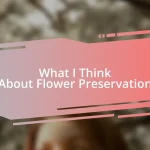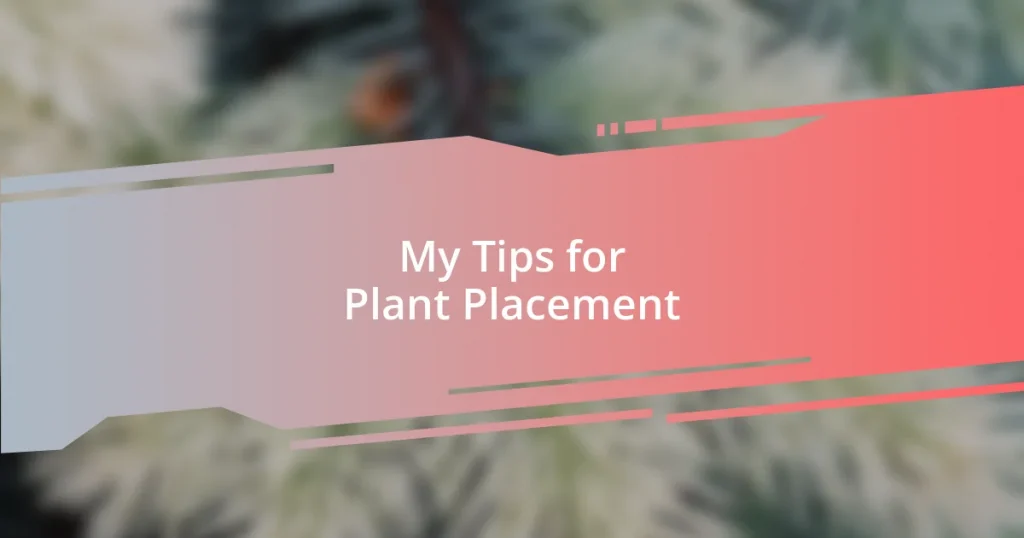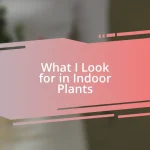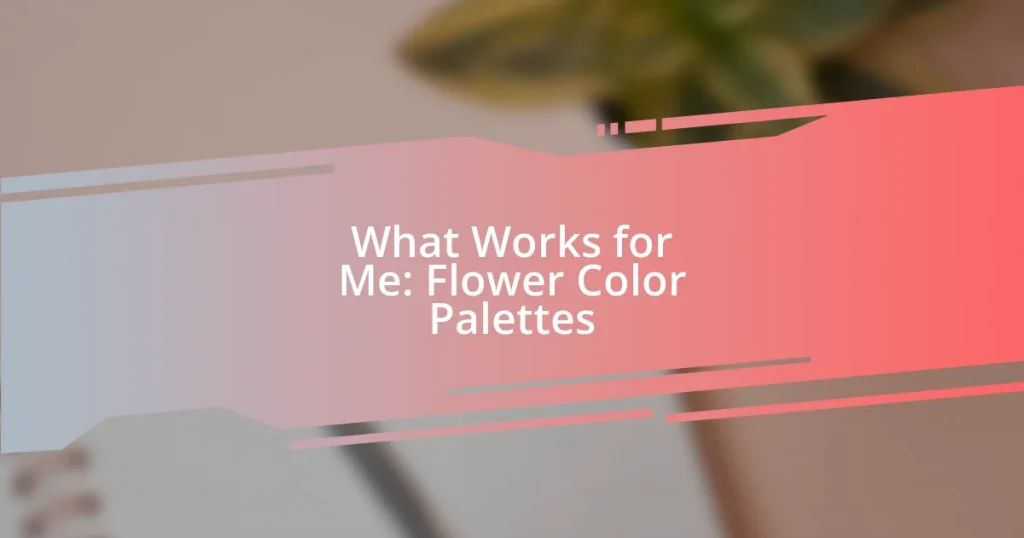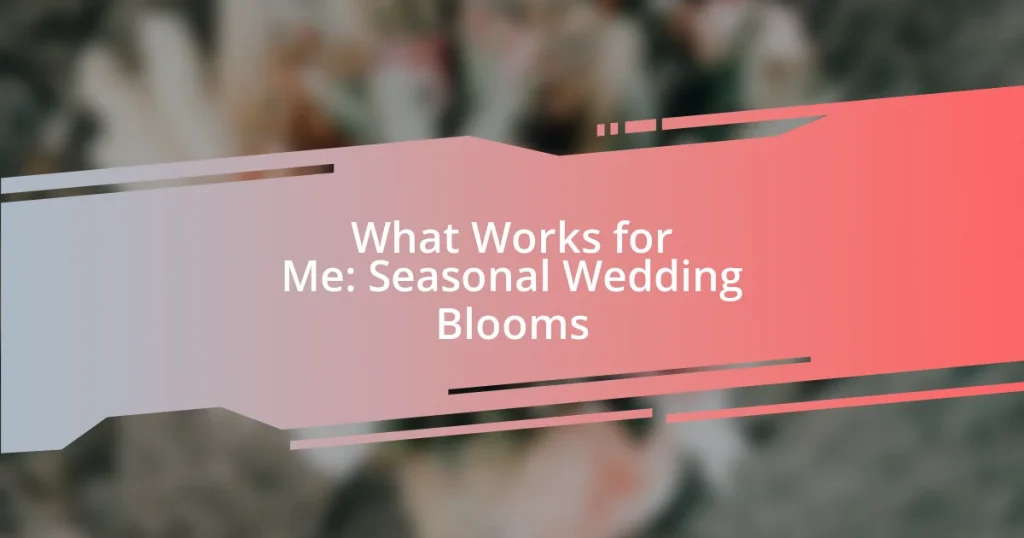Key takeaways:
- Understanding a plant’s specific needs for light, water, temperature, and humidity is crucial for its health and growth.
- Assessing natural light conditions in your home helps ensure proper placement and care for different plant types.
- Rotating plants regularly promotes balanced growth and allows for a deeper connection with your indoor gardening journey.

Understand your plant needs
Understanding your plant’s needs is truly the foundation of a thriving indoor garden. I remember the day I placed my first fern in a spot that was just a bit too sunny. Watching it wilt away broke my heart! It taught me that each plant has specific requirements when it comes to light, water, and humidity. Have you ever felt that disparity between what you expect and what your plants actually prefer?
When considering light, for instance, think about where the sun hits your space throughout the day. I’ve found that my snake plant thrives in a corner that receives indirect light but never direct sun—just a touch of shade. What’s fascinating is that some plants, like succulents, crave that intense light while others prefer the gentler glow. It’s enlightening to see how different conditions can drastically affect growth.
Then there’s water—underwatering and overwatering are two sides of the same dilemma. A few years ago, I nearly lost a beautiful pothos because I was too eager with the watering can. It’s a real learning curve, right? Knowing your plant’s preferences and adjusting your care routine accordingly can make all the difference. Take a moment to observe the little signs your plants give you; they might be more communicative than you think!

Assess natural light conditions
To truly understand how to place your plants, assessing natural light conditions is essential. I’ve learned the hard way that my living room, with its large windows, can be deceiving. I put a delicate peace lily there once, thinking it would thrive in the bright environment. Instead, it struggled and lost many of its leaves due to too much direct sunlight. Observing how light changes during the day is crucial. Pay attention to where shadows fall and how different areas of your home warm up with the sun.
Here are some tips for evaluating light conditions:
- Morning Light vs. Afternoon Light: Morning light tends to be cooler and softer, while afternoon sun can be intense and harsh.
- Duration: Track how many hours each area receives sunlight. Some plants may only need a few hours, while others thrive in all-day sun.
- Type of Light: Identify whether the light is direct (shining directly into the space) or indirect (filtered through curtains or bouncing off walls).
- Seasonal Changes: Remember, light levels can shift with the seasons. What works in summer may not apply in winter!
By considering these factors, you can create a nurturing environment for your plants that aligns with their natural needs.

Choose the right room
Choosing the right room for your plants significantly impacts their growth. I’ll never forget when I placed a humidity-loving monstera in a dry kitchen. I thought the warmth from cooking would be beneficial, but it quickly turned crispy! It became clear that not only light matters—humidity and temperature play vital roles in a plant’s happiness too. Think about where in your home you have natural humidity. Bathrooms and kitchens can be perfect for tropical plants, while a drafty hallway might not be the best spot for sensitive varieties.
Another factor to consider is the general atmosphere of the room. For example, a quiet home office suits calmer plants like snake plants, while a lively family room may suit more robust varieties that can tolerate a bit of roughhousing, like pothos or rubber plants. Reflect on how active the space is—if it’s a room bustling with people, your plants might need a space where they can grow peacefully without being disturbed too often.
| Room Type | Best Suitable Plants |
|---|---|
| Bright Living Room | Succulents, Cacti |
| Bathroom | Ferns, Peace Lilies |
| Kitchen | Herbs, Spider Plants |
| Office | Snake Plants, ZZ Plants |

Consider temperature and humidity
When I first started my indoor garden, I overlooked temperature and humidity, thinking they weren’t that crucial. I placed a few ferns in my living room, where the air always felt dry. It was heartbreaking to watch them wilt and lose their vibrant green leaves. A sudden realization hit me: these plants thrived in a more humid environment. Learning about the specific needs of each plant can save you from quite an emotional rollercoaster!
Humidity is particularly important for tropical plants, and I remember when I decided to group my humidity-lovers together in the bathroom. It felt like a mini-jungle, thriving from the steam after showers! I truly didn’t expect the transformation; the droopy leaves perked up almost overnight. Have you ever noticed how misting plants can change their demeanor? It’s as if they take a deep breath and sigh happily!
Temperature also plays a significant role in plant placement. I experienced this firsthand when I tucked my snake plant too close to an air vent. I thought the airflow would keep it cool, but it turned out to be a wind tunnel of despair! It’s essential to ensure that plants aren’t positioned where cold drafts or heat sources can wreak havoc. Finding that sweet spot in your home where temperature and humidity align with your plant’s needs is truly a game changer!

Plan for growth and size
Planning for growth and size involves understanding how a plant’s eventual size will impact its surroundings. I remember when my beloved fiddle leaf fig started reaching for the ceiling—not only was it a stunning sight, but it also made me realize how quickly they can outgrow their initial space. If I had positioned it closer to a window rather than in the corner of my living room, I might have saved myself from having to find a larger pot and the right spot to sustain its size.
When I first began placing larger plants in my home, I didn’t fully appreciate their expanding canopies. There was that one time I placed a tall dracaena near a door, only to find myself constantly dodging its leaves each time I walked past. It was a constant reminder that I need to account for their width as much as their height. Thinking ahead about where these larger plants will fit can streamline your experience, making sure you enjoy their presence instead of grappling with them daily.
Don’t hesitate to consider the vertical space in your home, either. I’ve found that using trellises or hanging pots can create beautiful layers of growth while also saving floor space. Have you ever experienced the joy of looking up and seeing a plant cascade down from above? It brings a refreshing element to a room and encourages creativity in arranging plant placements. Planning for growth goes beyond just potential—it invites possibilities!
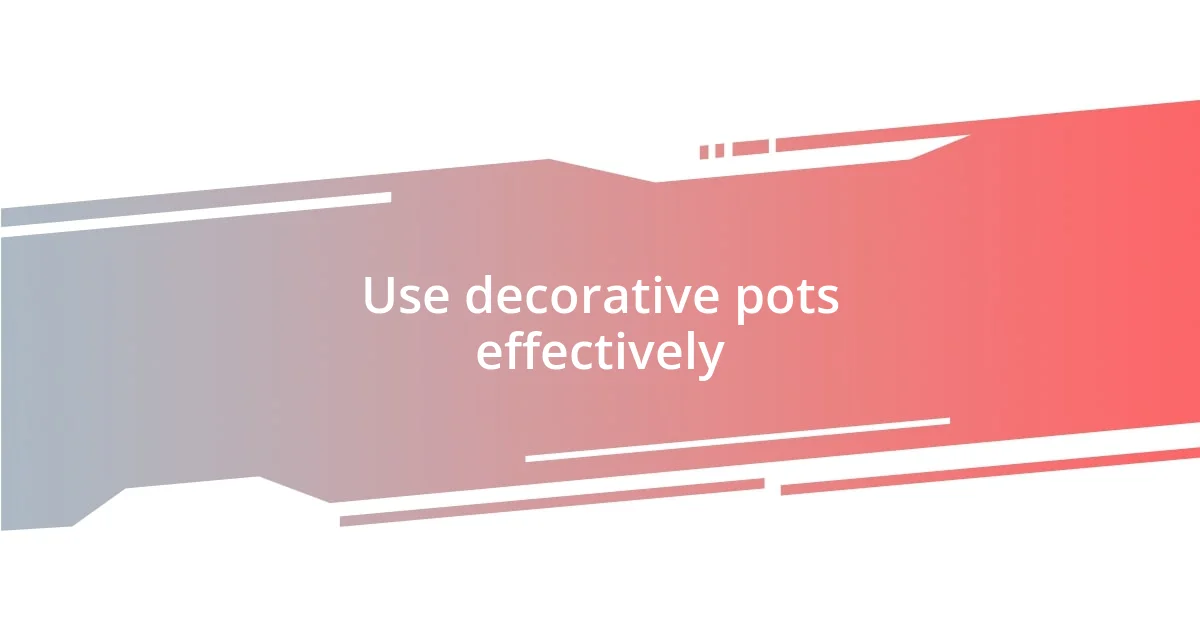
Use decorative pots effectively
Using decorative pots effectively can truly elevate your plant game and enhance your home’s atmosphere. I remember my excitement when I came across a vibrant, hand-painted ceramic pot at a local market. I immediately envisioned it cradling a cheerful pothos, adding a pop of color to my living room. It turned out to be a perfect match for my plant’s energetic vibe, creating a beautiful focal point that drew compliments from visitors. A simple decorative pot not only carries a plant but also tells a story!
When selecting pots, consider materials and styles that reflect your personality. I once experimented with sleek, modern pots in a matte finish, thinking they’d fit perfectly with my minimalist decor. However, I quickly felt they lacked warmth, and it wasn’t long before I switched them for rustic terracotta pots. They brought a cozy, homey feel that resonated better with my space. Have you ever felt that magical connection between your decor and your plants? It’s all about creating harmony in your living environment.
Finally, don’t underestimate the power of pot placement. I was surprised at how shifting a plant from a corner shelf to a windowsill completely transformed the energy in my room. The added sunlight seemed to infuse life not only into the plant but also into the entire space. Placing decorative pots in varied heights and layers can also create visual interest; it feels like an art installation. Ever thought about how a few simple changes can rejuvenate a dreary spot in your home? I’ve learned that even the smallest adjustments can lead to breathtaking results!
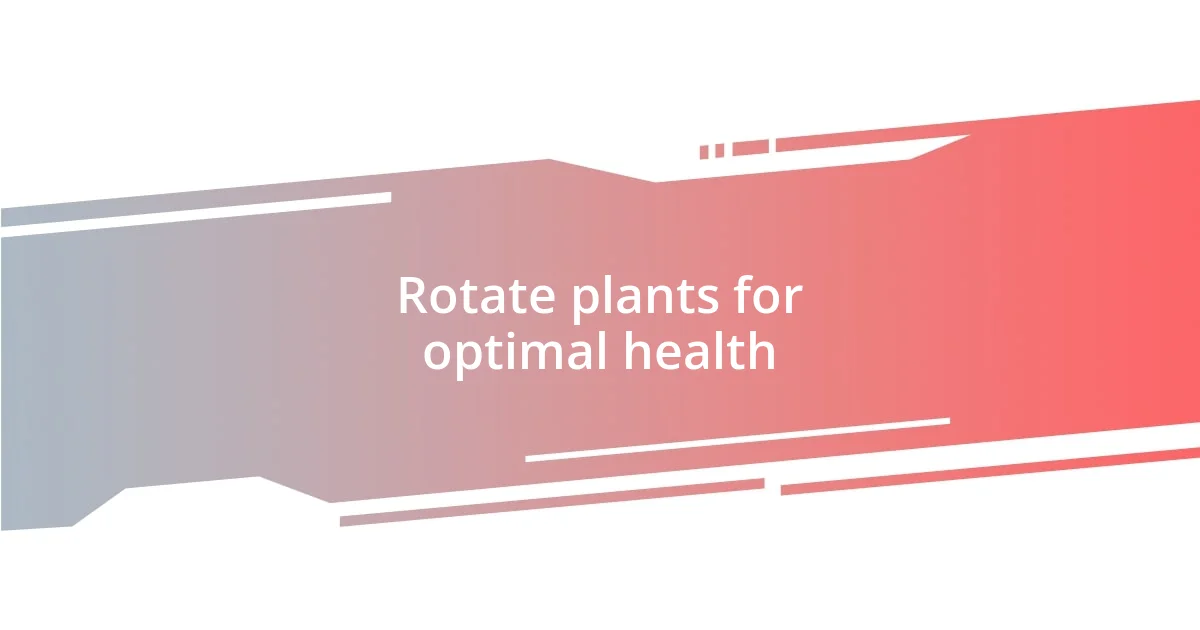
Rotate plants for optimal health
Rotating plants is a crucial practice that can significantly enhance their health and vitality. I learned this the hard way when I had a snake plant nestled against the wall; it thrived on the light that reached it, but I noticed one side growing much faster than the other. After giving it a gentle turn, I could practically see how grateful it was, with new growth unfolding evenly around the pot. Doesn’t it feel rewarding to see your plants respond positively to your care?
Moreover, regular rotation helps prevent issues like leaf burn or leggy growth, common problems I encountered with my peace lily. By shifting it every few weeks, I not only ensured balanced sunlight exposure but also discovered that its blooms lasted longer. It’s fascinating how something so simple can offer such a significant impact! Have you considered how many plants could benefit from a little spin every now and then?
It’s also worth noting that rotating your plants periodically can engage you further in your gardening journey. Each turn unveils new perspectives, allowing you to observe them closely and appreciate their beauty from different angles. I find myself talking to my plants more during these rotations, examining their leaves and noticing subtle changes, which deepens my connection with them. Isn’t it interesting how a small act can lead to a greater relationship with nature?



